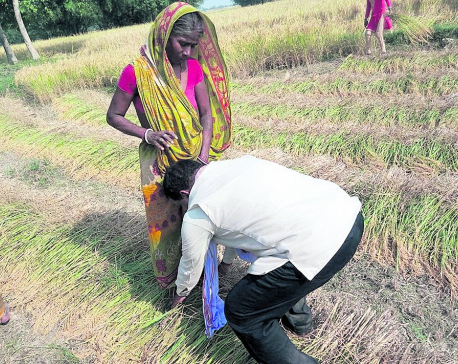
OR

The national power utility should be handed over to the people. Federalism offers Nepal a unique opportunity to transform NEA
When Kulman Ghising, the Managing Director of the state-owned electric utility Nepal Electricity Authority (NEA), rose to speak at the Nepal Investment Summit in March, the audience gave him a standing ovation before he had even said a single word. Several in the audience nudged others around them who were still seated to stand up and clap. The spontaneous applause was a rare display of unanimity in Nepal and an indication of how deeply Ghising had penetrated the Nepali psyche.
At the end of the summit, no one remembered the US $13.5 billion of investments pledged. But everyone remembered the standing ovation.
Ghising is clearly our person of the year for his heroics in ending load-shedding (forced blackouts). Can he now transform a rickety state-owned enterprise into a modern electricity utility?
I’m sure there are many ways to do it. But the one that I have in mind requires him to do the unthinkable: hand NEA over to the people.
Federalism offers Nepal a unique opportunity to transform NEA. The proposition I offer is to devolve the distribution part of NEA to municipality-owned distribution utilities.
Local level restructuring has now established 744 units, consisting of 481 rural municipalities, 246 municipalities, 13 sub-metropolitan cities and one metropolitan city. A proposed constitutional amendment may add more. Electricity is a shared jurisdiction between the federal, provincial and local levels.
Under this proposition, NEA would be devolved into 261 separate entities, with all urban municipalities (i.e., municipalities, sub-metropolitan cities and metropolitan city) owning a distribution utility and 481 rural distribution utilities grouped within a holding company.
The municipal utilities must be autonomous, financially independent corporate entities empowered in all aspects of their management: purchasing power to meet demand, collecting end-user payments, managing their costs and revenues, and investing in their own growth.
The rural utilities operate in much the same way as municipalities except that because each one would be too small to bear overheads on their own, the utilities will be contained within a larger holding company. The company operates as a cooperative, centralizing power purchases, procurement, fiscal management and providing technical and managerial backstopping.
The idea of migrating from a monopoly utility to 261 small utilities in a system that does not generate even 2,000 MW may at first seem like overkill. But 261 is not a big number when you put things into perspective. There are, for instance, 125 political parties in Nepal. Political saturation, or cynical humour aside, the idea of many municipalities-owned utilities, is a forward-looking vision specifically engineered to Nepal’s socio-economic and political conditions. Among other competing models, it has the highest likelihood of catalysing the sector’s growth.
Modern grids are shrinking, devolving into a network of smaller grids. Enabled by advances in communications, remote management technologies and integration of distributed renewable energy resources, the future will be of smaller grids within an interconnected mesh. The best performing utilities are ones that are close to the customers.
The 21st century utility will be a village not the sprawling Roman Empire. As we build our new federation, we must build for the new century, not the last.
The best, perhaps the only, truly successful story of Nepal’s development has been around community ownership. There is unambiguous evidence from across sectors—health, education, forestry, water, energy, sanitation, roads—that community-owned operations yield better performance and long-term results relative to central state-owned entities.
Community ownership does have its limits: they are often unable to tap financial markets, to execute complex financial, technical and managerial operations, and occasionally end up further strengthening local elites instead of empowering the marginalized. Despite these limitations, on the whole, community-owned systems in Nepal exhibit stronger governance, oversight, accountability and transparency than centrally-owned entities.
The model of municipality-owned distribution company must be an enhanced second-generation version that retains the spirit of community ownership but modernizes the structure. The enhancements must include, for instance, transforming community ownership into corporate entities and public-private-partnerships that enable private investments and management, particularly from local communities.
Nepal already has a rich history of community-based systems on electricity. Following the 1990 Act that allowed communities to take over last mile electricity distribution and revenue collection, some 300 local electricity entities (companies, user groups and cooperatives) are already operating across the country.
Currently, local distribution networks (e.g., placement of sub-stations, feeders), in some cases, are already structured around municipal boundaries. If municipalities were given control of distribution, operations of local distribution network could be easily isolated and handed over. In other cases, the operational control of the local distribution network will have to be shared across several municipalities.
But although modalities for sharing operational control of local distribution networks could be shared in the interim, in the longer-term all municipalities must have the ability to operate their distribution networks on their own. The constitution requires this—because electricity is a shared jurisdiction between the centre, province and local bodies, operational control of the distribution network must also be provided to the local level.
For a long time, electricity reformers in Nepal have been seeking to unbundle NEA—i.e., restructure NEA into three independent and separate generation, transmission and distribution entities. Development partners have spent millions of dollars in expensive training, studies, reports, exposure visits and conferences to make this happen.
The evidence from developing countries with weak broader market maturity and high political interference is that unbundling doesn’t always lead to expected outcomes when it isn’t clear what will follow.
Unbundling in Nepal’s case has seemed like, to borrow from an American football expression, a “Hail Mary”—toss the football in the air in the final minutes of the game and hope that someone from your team catches it to run across the end line. In Nepal’s current political economy, unbundling without detailing what is to follow will only result in political bhad-phad (control-sharing).
The model of municipality-owned distribution companies ushers in unbundling as a natural by-product, thus shifting the focus to where we want to go. Political consensus will then be easier to achieve. It would also offer a far more interesting opportunity of not just unbundling into generation, transmission and distribution units, but also modifying the transmission entity into a wires company (i.e., one that would own all transmission and distribution assets without any generation or distribution duties).
The model would also usher in a vibrant power market as municipalities compete to purchase power. The wires company will emerge as a neutral load-dispatcher.
One big challenge of Nepal’s power sector is over-emphasis on investments for generation and transmission (to a lesser extent). There isn’t enough attention on investment in distribution, which is now a key bottleneck in the sector’s expansion. More importantly, perhaps, there is little discussion of how private sector investment and engagement can be leveraged on distribution. The model of municipality-owned utility enables private player participation in distribution, opening a new frontier for the power sector.
To think big on generation capacity—10,000 MW—we need to think local on distribution.
Bishal_thapa@hotmail.com
You May Like This

The power rests in the people
Mahesh Yadav, the left alliance candidate for provincial assembly election in constituency 2(b) of Saptari, canvassing vote from a local... Read More...

Gulmi people hit as landslide blocks road, interrupts power, communication
GULMI, July 22: The vehicular movement has been halted along the Chorkote-Shantipur road section after the landslide blocked the road... Read More...

People power
Many had doubted the feasibility of the second round of local election that had been scheduled in the middle of... Read More...




Just In
- MoHP cautions docs working in govt hospitals not to work in private ones
- Over 400,000 tourists visited Mustang by road last year
- 19 hydropower projects to be showcased at investment summit
- Global oil and gold prices surge as Israel retaliates against Iran
- Sajha Yatayat cancels CEO appointment process for lack of candidates
- Govt padlocks Nepal Scouts’ property illegally occupied by NC lawmaker Deepak Khadka
- FWEAN meets with President Paudel to solicit support for women entrepreneurship
- Koshi provincial assembly passes resolution motion calling for special session by majority votes








_20220508065243.jpg)






Leave A Comment